Abstract
Racism is associated with increased psychosocial stress and blood pressure in blacks. However, little is known of the relationship of racism to other features of insulin resistance syndrome. This study examined the relationship of internalized racism to abdominal obesity and elevated blood pressure in a population of black Caribbean women aged 20-55 years. One hundred thirty-three randomly selected women from the island of Barbados comprised the study sample. Data collected included anthropometric and blood pressure measurements, and information about internalized racism, anxiety, and depression. The stress measures including anxiety, depression, and internalized racism were significantly correlated with waist circumference (r = .25, r = .21, and r = .25). After adjusting for age, education, anxiety, and depression, internalized racism remained significantly correlated with waist circumference. The odds ratio associated with development of abdominal obesity among those with high internalized racism (OR = 2.4 [95% CI, 1.1,5.3]) was significant (P < .05) after adjusting for age, education, and body mass index. Blood pressure was not independently related to internalized racism. Studies comparing black-white differences in diseases for which abdominal obesity is a risk factor (eg, diabetes and cardiovascular disease) should take into account the potential role of internalized racism in defining the differences between ethnic groups.
Full text
PDF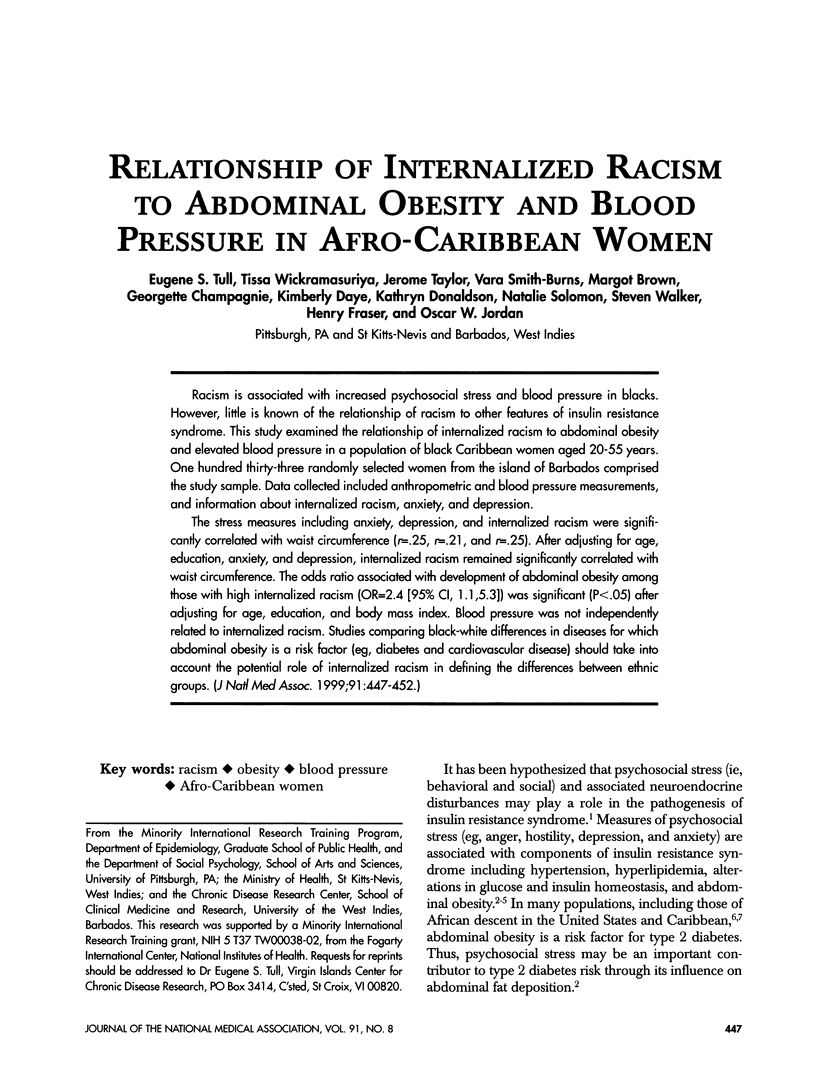
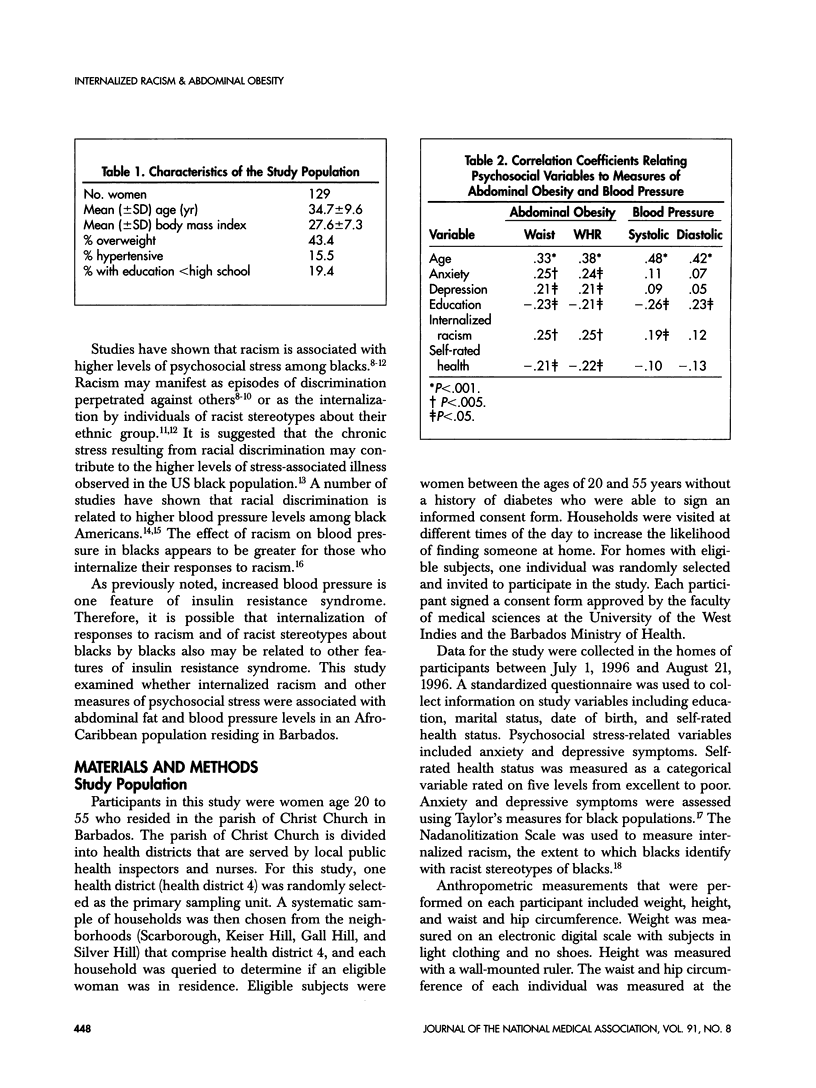
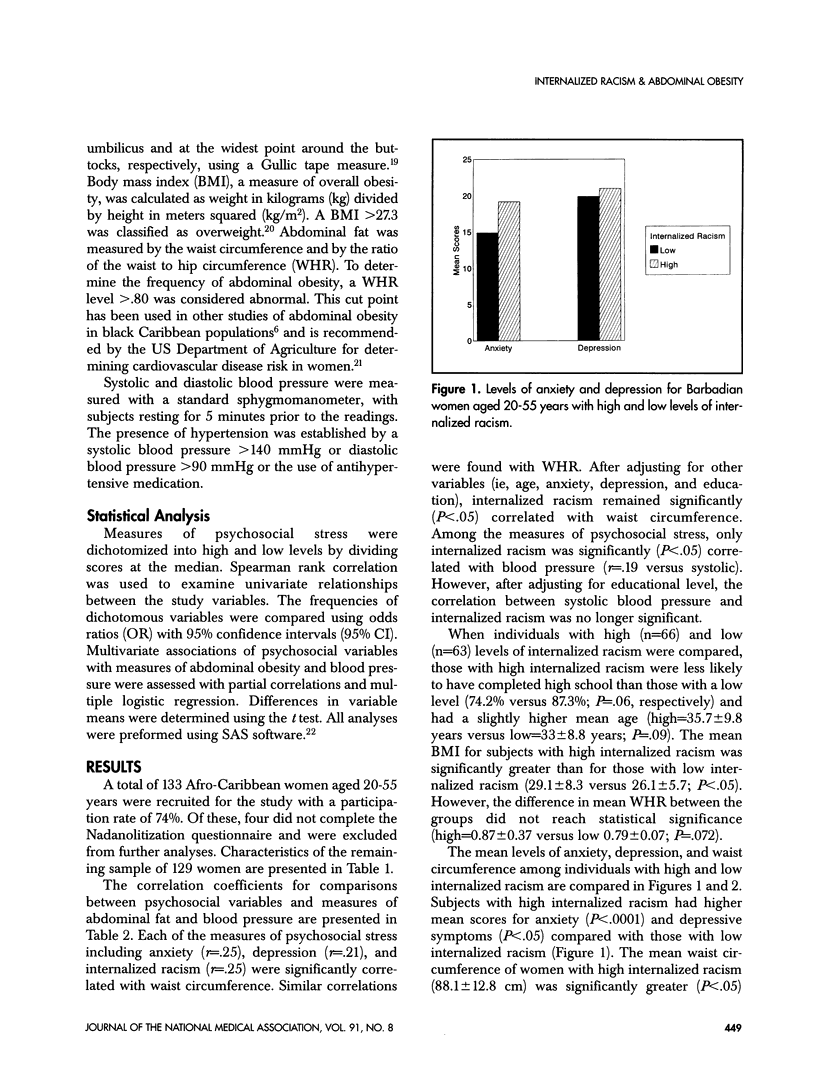
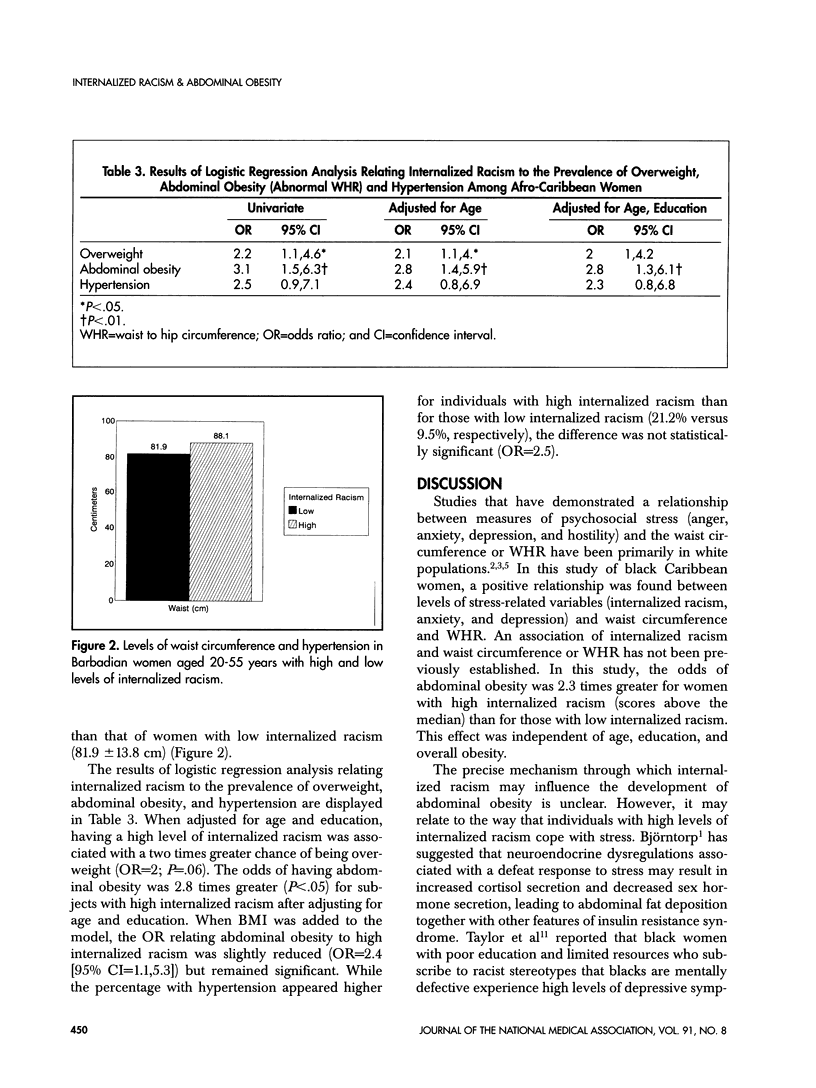
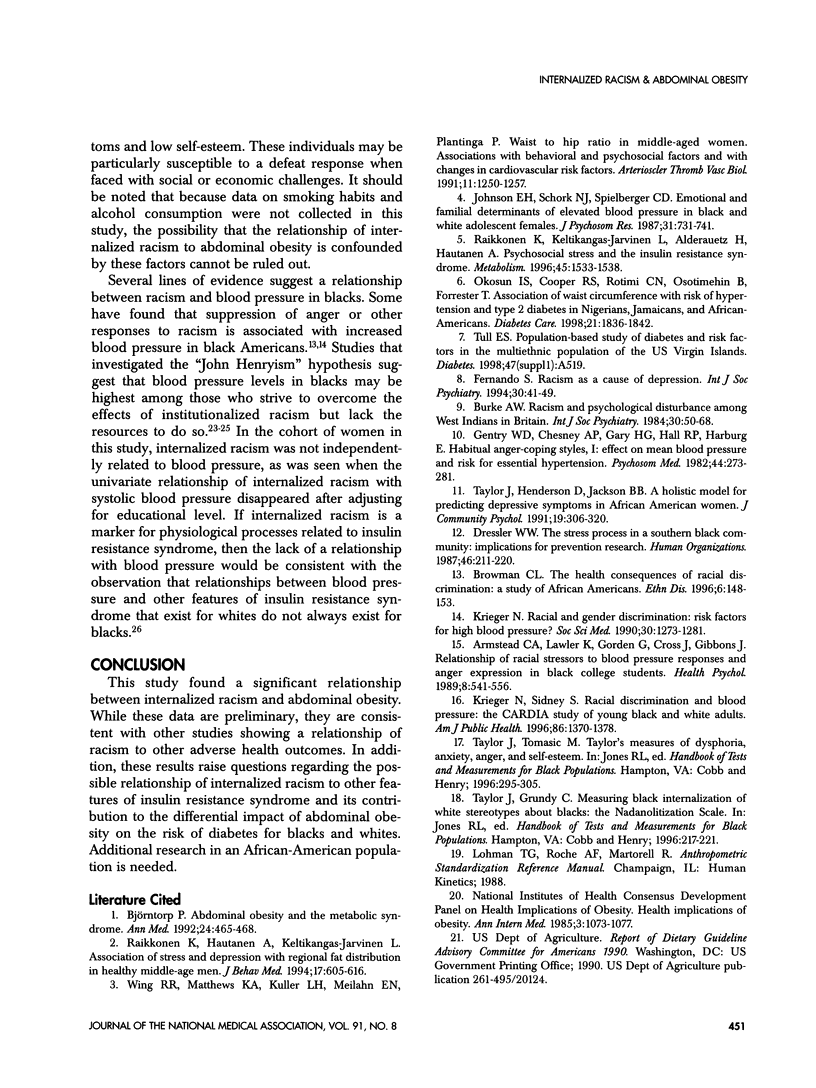
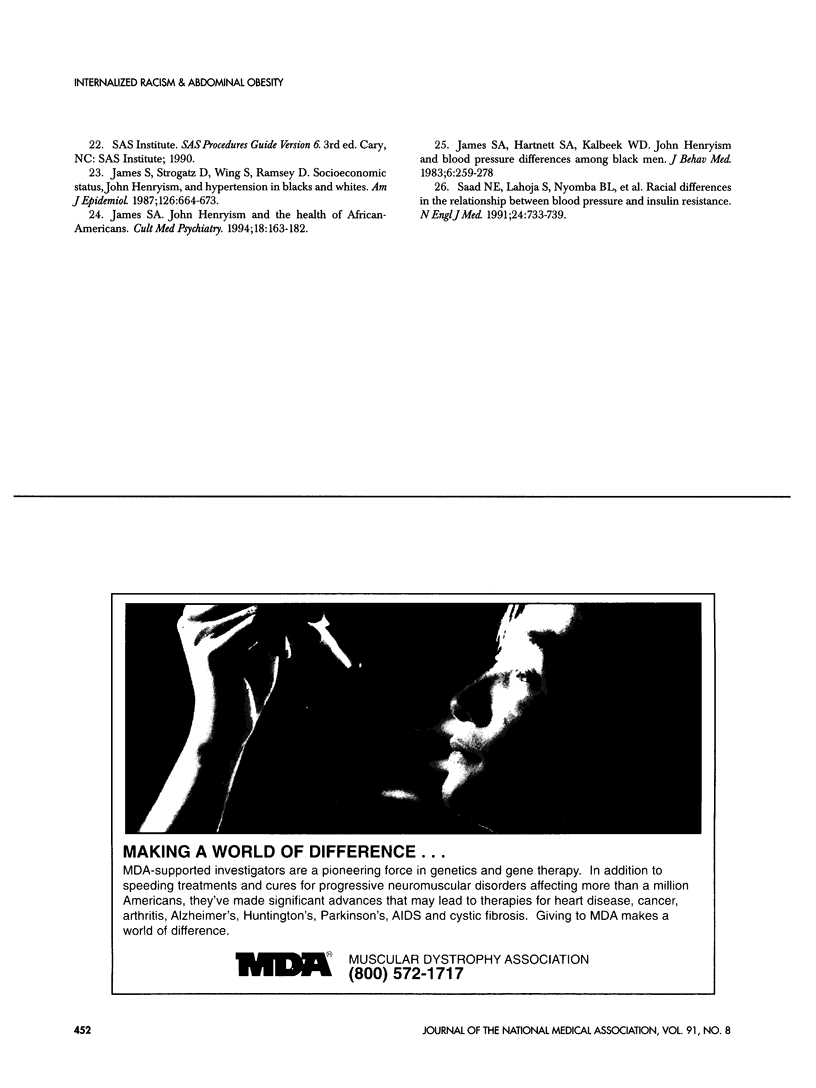
Selected References
These references are in PubMed. This may not be the complete list of references from this article.
- Armstead C. A., Lawler K. A., Gorden G., Cross J., Gibbons J. Relationship of racial stressors to blood pressure responses and anger expression in black college students. Health Psychol. 1989;8(5):541–556. doi: 10.1037//0278-6133.8.5.541. [DOI] [PubMed] [Google Scholar]
- Björntorp P. Abdominal obesity and the metabolic syndrome. Ann Med. 1992 Dec;24(6):465–468. doi: 10.3109/07853899209166997. [DOI] [PubMed] [Google Scholar]
- Broman C. L. The health consequences of racial discrimination: a study of African Americans. Ethn Dis. 1996 Winter-Spring;6(1-2):148–153. [PubMed] [Google Scholar]
- Burke A. W. Racism and psychological disturbance among West Indians in Britain. Int J Soc Psychiatry. 1984 Spring;30(1-2):50–68. doi: 10.1177/002076408403000108. [DOI] [PubMed] [Google Scholar]
- Fernando S. Racism as a cause of depression. Int J Soc Psychiatry. 1984 Spring;30(1-2):41–49. doi: 10.1177/002076408403000107. [DOI] [PubMed] [Google Scholar]
- James S. A., Hartnett S. A., Kalsbeek W. D. John Henryism and blood pressure differences among black men. J Behav Med. 1983 Sep;6(3):259–278. doi: 10.1007/BF01315113. [DOI] [PubMed] [Google Scholar]
- James S. A. John Henryism and the health of African-Americans. Cult Med Psychiatry. 1994 Jun;18(2):163–182. doi: 10.1007/BF01379448. [DOI] [PubMed] [Google Scholar]
- James S. A., Strogatz D. S., Wing S. B., Ramsey D. L. Socioeconomic status, John Henryism, and hypertension in blacks and whites. Am J Epidemiol. 1987 Oct;126(4):664–673. doi: 10.1093/oxfordjournals.aje.a114706. [DOI] [PubMed] [Google Scholar]
- Johnson E. H., Schork N. J., Spielberger C. D. Emotional and familial determinants of elevated blood pressure in black and white adolescent females. J Psychosom Res. 1987;31(6):731–741. doi: 10.1016/0022-3999(87)90022-5. [DOI] [PubMed] [Google Scholar]
- Krantz D. S., Arabian J. M., Davia J. E., Parker J. S. Type A behavior and coronary artery bypass surgery: intraoperative blood pressure and perioperative complications. Psychosom Med. 1982 Jul;44(3):273–284. doi: 10.1097/00006842-198207000-00005. [DOI] [PubMed] [Google Scholar]
- Krieger N. Racial and gender discrimination: risk factors for high blood pressure? Soc Sci Med. 1990;30(12):1273–1281. doi: 10.1016/0277-9536(90)90307-e. [DOI] [PubMed] [Google Scholar]
- Krieger N., Sidney S. Racial discrimination and blood pressure: the CARDIA Study of young black and white adults. Am J Public Health. 1996 Oct;86(10):1370–1378. doi: 10.2105/ajph.86.10.1370. [DOI] [PMC free article] [PubMed] [Google Scholar]
- Okosun I. S., Cooper R. S., Rotimi C. N., Osotimehin B., Forrester T. Association of waist circumference with risk of hypertension and type 2 diabetes in Nigerians, Jamaicans, and African-Americans. Diabetes Care. 1998 Nov;21(11):1836–1842. doi: 10.2337/diacare.21.11.1836. [DOI] [PubMed] [Google Scholar]
- Räikkönen K., Hautanen A., Keltikangas-Järvinen L. Association of stress and depression with regional fat distribution in healthy middle-aged men. J Behav Med. 1994 Dec;17(6):605–616. doi: 10.1007/BF01857600. [DOI] [PubMed] [Google Scholar]
- Räikkönen K., Keltikangas-Järvinen L., Adlercreutz H., Hautanen A. Psychosocial stress and the insulin resistance syndrome. Metabolism. 1996 Dec;45(12):1533–1538. doi: 10.1016/s0026-0495(96)90184-5. [DOI] [PubMed] [Google Scholar]
- Saad M. F., Lillioja S., Nyomba B. L., Castillo C., Ferraro R., De Gregorio M., Ravussin E., Knowler W. C., Bennett P. H., Howard B. V. Racial differences in the relation between blood pressure and insulin resistance. N Engl J Med. 1991 Mar 14;324(11):733–739. doi: 10.1056/NEJM199103143241105. [DOI] [PubMed] [Google Scholar]
- Wing R. R., Matthews K. A., Kuller L. H., Meilahn E. N., Plantinga P. Waist to hip ratio in middle-aged women. Associations with behavioral and psychosocial factors and with changes in cardiovascular risk factors. Arterioscler Thromb. 1991 Sep-Oct;11(5):1250–1257. doi: 10.1161/01.atv.11.5.1250. [DOI] [PubMed] [Google Scholar]


